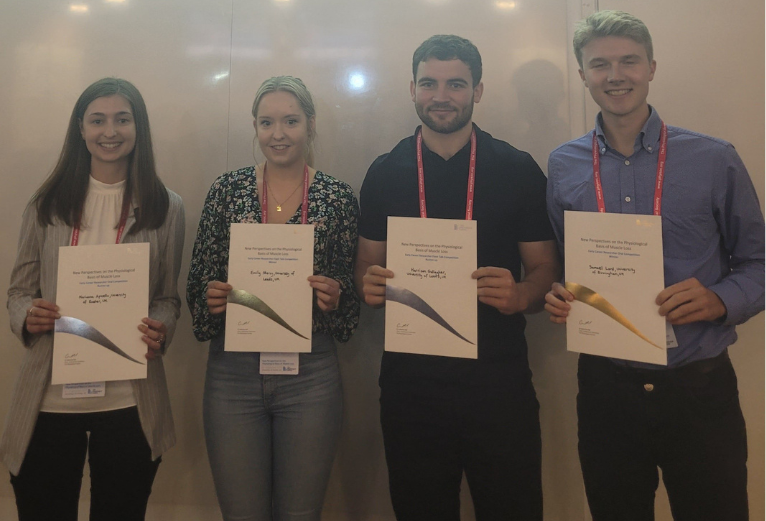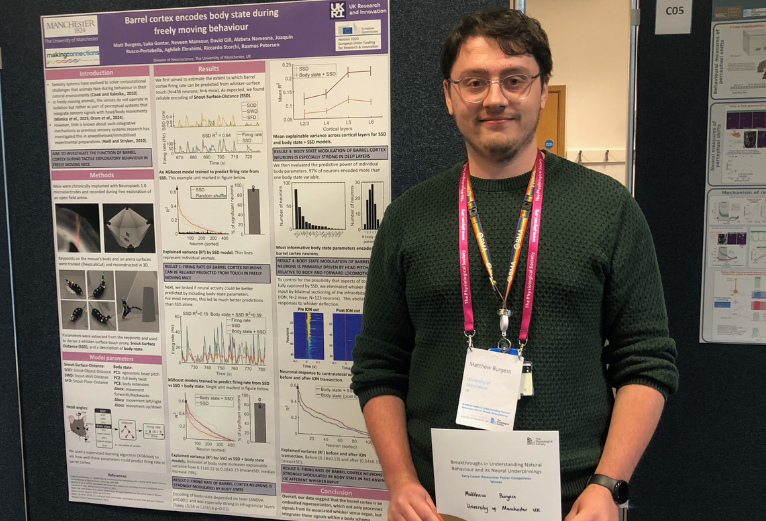
2024 presentation awardees
Last month, we were joined by physiologists in the areas of muscle loss and the neural basis of natural behaviour at our two-day scientific meetings, New Perspectives on the Physiological Basis of Muscle Loss and Breakthroughs in Understanding Natural Behaviour and its Neural Underpinnings. The international panels of invited speakers were complemented by oral communication, flash talk and poster sessions, highlighting the high quality research taking place in these areas. Our early career competition winners and runners up tell us more about the work they presented at the meetings below.
Samuel Lord, University of Birmingham, UK
Winner of the Early Career Researcher Oral Competition at New Perspectives on the Physiological Basis of Muscle Loss
Skeletal muscle mass and function progressively decline with age. This decline is exacerbated in later life, contributing to the development of sarcopenia which is prevalent in many chronic diseases and a predictor of mortality. The molecular mechanisms driving this decline are not fully understood, slowing the development of therapeutic interventions. Proteins and their post-translational modifications (PTMs) are key drivers of cellular function, and when perturbed are the cause of many muscular disorders. A PTM called ubiquitylation is dysregulated in various models of ageing, however its specific role and impact in skeletal muscle ageing remain poorly understood. The aim of my research is to provide a better understanding of how the abundance of proteins and their ubiquitin modifications change in skeletal muscle with age. To deliver this, we performed mass spectrometry-based proteomics on skeletal muscle from young and old male and female mice.
Our analysis revealed extensive age-related protein alterations in multiple cellular components, including increases in spliceosome and endoplasmic reticulum protein levels and a decline in mitochondrial ribosome proteins. We observed sex-specific ageing effects, particularly in the unfolded protein response in which only males show an age-related increase in pro-folding chaperones. We also found site-specific changes in protein ubiquitylation, notably a reduction on a histone H2B isoform. Importantly, this work provides a resource of age-associated protein and ubiquitin-related modification changes in mouse skeletal muscle, laying the groundwork for future mechanistic studies related to skeletal muscle ageing.
Emily Storey, University of Leeds, UK
Winner of the Early Career Researcher Flash Talk Competition at New Perspectives on the Physiological Basis of Muscle Loss
The onset and progression of skeletal muscle pathology is a debilitating process that is observed in various chronic conditions, including heart failure. Myocardial infarction is a leading cause of mortality and morbidity globally and is a primary risk factor for heart failure. The main symptoms in people with heart failure is exercise intolerance, but this is poorly related to cardiac dysfunction. In contrast, heart failure is commonly associated with skeletal muscle pathology and this is strongly associated with greater symptoms. However, the mechanisms underlying this relationship remain poorly understood.
Here, we studied a mouse model of heart failure post MI, surgically induced by ligating the left coronary artery, to investigate what contributes towards muscle pathology in heart failure. We specifically focused on a role for disturbances in myogenic homeostasis. Cardiac dysfunction was confirmed via in vivo echocardiography and structural changes via ventricular cryosections. We identified skeletal muscle atrophy in mice with heart failure compared to controls. In addition, in vitro isolated muscle preparations from mice with HF showed overt contractile dysfunction compared to controls. By optimising a method of fluorescent activated cell sorting, we further identified that myogenic properties were different in HF compared to controls. Ongoing work in our laboratory is now exploring a potential role for how disturbed myogenesis and other mechanisms in the “niche” influence muscle pathology in heart failure.

Matthew Burgess, University of Manchester, UK
Winner of the Early Career Researcher Poster Competition at Breakthroughs in Understanding Natural Behaviour and its Neural Underpinnings
Sensory systems have evolved to solve computational challenges that animals face during behaviour in their natural environments. To illuminate how sensory cortex operates under such conditions, we investigated the function of neurons in whisker-related Somatosensory Cortex (wS1) of freely moving mice, engaged in tactile exploratory behaviour. By recording neural activity from wS1 whilst tracking the mouse body in 3D, we found that wS1 neurons are substantially modulated by body state (configuration of individual body-parts and their derivatives), even in the absence of whisker afferent input. Most neurons were modulated by multiple dimensions of body state, with the most prominently encoded being the angle of the head to the body and locomotion speed. Overall, our data suggest that sensory cortex functions as an embodied representation, which integrates signals from its associated sense organ within a body schema.
Marianna Apicella, University of Exeter, UK
Runner up of the Early Career Researcher Oral Competition at New Perspectives on the Physiological Basis of Muscle Loss
Novel data was presented on the relationship between sex hormone concentrations and myofibrillar protein synthesis (MyoPS) following resistance exercise and protein ingestion in young females. For this to be determined, seventeen, healthy, eumenorrheic females attended the lab twice, during the early follicular and late follicular phases of the menstrual cycle. On each visit, blood samples were collected to measure serum sex hormone concentrations (oestradiol, free oestradiol index, progesterone, oestrogen to progesterone ratio, testosterone, and free testosterone). During a primed continuous infusion of L-[ring–2H5]-phenylalanine, muscle biopsies were collected before and during a 4 hour postprandial post-exercise period to assess MyoPS. Correlations were performed between sex hormone concentrations and MyoPS. Graphs were presented that showed a moderate correlation between free testosterone and postexercise MyoPS from 0-4 h, and this showed a trend under the basal and early postexercise 0-2 h period. Total testosterone was also shown to moderately correlate with postexercise MyoPS from 0-4 h but the remainder of the sex hormones (oestradiol, free oestradiol index, progesterone and oestrogen to progesterone ratio) did not significantly correlate with MyoPS over 0-4 h or at any other time point. These findings suggest that testosterone, both total and free, may play an important role in the regulation of muscle mass in females.

Harrison Gallagher, University of Leeds, UK
Runner up of the Early Career Researcher Flash Talk Competition at New Perspectives on the Physiological Basis of Muscle Loss
Ageing is associated with a reduction in muscle mass and strength termed sarcopenia which is associated with lower quality of life. Sarcopenia effects limb muscles required for movement and respiratory muscles which support breathing. Other than exercise, there are currently no established treatments to improve muscle mass and strength in elderly humans. Long-term calorie restriction prolongs lifespan and improves sarcopenia in several animal models of ageing. Despite this, long-term calorie restriction is limited by both desire and commitment in humans.
Therefore, short-term bouts of calorie restriction may provide a more feasible alternative in elderly humans. Currently, this project is exploring the effects of short-term mild calorie restriction on sarcopenia. By carefully assessing muscle structure and function in both the limb and respiratory muscles, we have found divergent results that show some beneficial and detrimental effects. Following recent global transcriptome profiling, we are currently investigating what underlying biological mechanisms may be involved to explain how short-term caloric restriction remodels skeletal muscle in ageing.
Chloe Roddis, University of Manchester, UK
Runner up of the Early Career Researcher Poster Competition at Breakthroughs in Understanding Natural Behaviour and its Neural Underpinnings
Light is used as an effective and non-invasive therapeutic option with little to no side effects, to improve sleep, mood, and general well-being. To utilise the full potential of light to improve mood and well-being, it is essential to determine the relationship between light and mood in human subjects in everyday life.
This study’s methodology will be the first to explore naturalistic light exposure and its relationship with emotional bias. 25 healthy volunteers were recruited for a 1-week light monitor study, whereby they wore two devices—an ActLumus light monitor (measuring Melanopic-EDI) for daytime use and a Fitbit for continuous tracking (activity, sleep, heart rate). During the week, participants completed several questionnaires, including baseline questionnaires, daily sleep diaries and subjective mood questionnaires. Additionally, objective mood tasks: Emotional Categorisation Test (ECAT), Emotional Recall Task (EREC) and Emotional Recognition Memory Task (EMEM) were conducted. This is the first time this emotional battery tests have been utilised to be completed over several days, not just in one sitting.
Preliminary results from five healthy volunteers, demonstrate the feasibility of the study. Results suggest no significant differences between positive or negative bias across days. There were also no significant differences between days and number of incorrect words, suggesting no practice effect for the tasks. We anticipate that the analysis of the complete dataset will reveal daily rhythmicity of mood, efficacy of objective emotion tasks in detecting mood variations in real-world settings, and relationships between light exposure, physiological variables, and mood in healthy volunteers.




